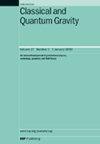伪太阳风对LISA探路者加速噪声的影响
IF 3.6
3区 物理与天体物理
Q2 ASTRONOMY & ASTROPHYSICS
引用次数: 0
摘要
伪太阳风效应是未来激光干涉仪空间天线(LISA)测量中的一个潜在噪声源。通过估算太阳风对LISA探路者(LPF)加速噪声的影响,约束了一种噪声耦合机制。虽然LISA是为无阻力差分测量而设计的,但预测实际影响既限制了操作环境,也评估了LISA是否可以提供偶然的空间天气观测。位于拉格朗日点L1的美国宇航局高级成分探测器(ACE)提供的数据是太阳风数据的可靠来源。对2016年3月1日至2016年6月23日的114 d时间内的数据集进行了比较。这段时间提供了最长的开放数据集,不受其他调试活动的干扰。为了评估空间天气的影响,对两颗卫星的数据进行了格式化、空白填充/插值,并进行了快速傅立叶变换,用于幅度、频谱密度和相干性比较。在LPF和ACE之间的相干图中没有看到太阳风效应;计划中的LISA观测频带的适度相干性可以归因于偶然。这一结果表明,在3个月的时间尺度上,太阳风加速度噪声的可测量相关性将是一个可以忽略不计的噪声源。LISA不太可能提供常规的太阳风测量信息。另一个来自太阳的噪音来源,太阳辐射压力,估计会产生更大的加速度噪音,但还没有被分析。本文章由计算机程序翻译,如有差异,请以英文原文为准。
Spurious solar-wind effects on acceleration noise in LISA Pathfinder
Spurious solar-wind effects are a potential noise source in future Laser Interferometer Space Antenna (LISA) measurements. One noise coupling mechanism is constrained by estimating solar-wind effects on acceleration noise in LISA Pathfinder (LPF). While LISA is designed for drag-free differential measurement, predicting the realistic impact both bounds the operational environment and assesses whether LISA could provide serendipitous space-weather observations. Data from NASA’s Advanced Composition Explorer (ACE), situated at the L1 Lagrange point, serves as a reliable source of solar-wind data. The data sets are compared over the 114 d time period from 1 March 2016 to 23 June 2016. This period gives the longest readily-available open data set, without interference from other commissioning activities. To evaluate space weather effects, the data from both satellites are formatted, gap-filled/interpolated, and fast-Fourier transformed for amplitude spectral density and coherence comparisons. Solar wind effects are not seen in a coherence plot between LPF and ACE; modest coherence in the planned LISA observational frequency band can be attributed to chance. This result indicates that measurable correlation due to solar-wind acceleration noise over 3 month timescales will be a negligible noise source. LISA is unlikely to inform solar wind measurements routinely. Another source of noise from the Sun, solar radiation pressure, is estimated to impart greater acceleration noise, but has yet to be analyzed.
求助全文
通过发布文献求助,成功后即可免费获取论文全文。
去求助
来源期刊

Classical and Quantum Gravity
物理-天文与天体物理
CiteScore
7.00
自引率
8.60%
发文量
301
审稿时长
2-4 weeks
期刊介绍:
Classical and Quantum Gravity is an established journal for physicists, mathematicians and cosmologists in the fields of gravitation and the theory of spacetime. The journal is now the acknowledged world leader in classical relativity and all areas of quantum gravity.
 求助内容:
求助内容: 应助结果提醒方式:
应助结果提醒方式:


